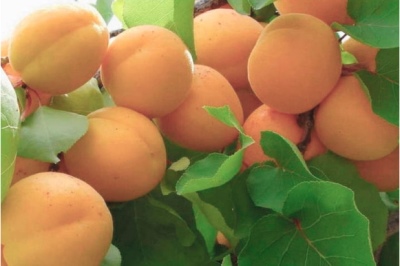
- Tree height, m: 2
- Flowers: 3 cm
- Fruit weight, g: 40
- Fruit color: bright orange
- Fruit taste: very sweet
- Separability of the bone from the pulp: good
- Appointment: universal
- Ripening terms: late
- Fruiting period: at the beginning of August
- Yield: high
The columnar apricot Prince Mart is a beautiful, very decorative, but at the same time uncomplicated variety in cultivation, capable of bearing abundant fruit even in the suburbs of Moscow. The tree is compact, does not take up much space, but requires annual pruning to stimulate fruiting. The fruits are suitable both for fresh consumption and for canning and processing.
Description of the variety
The tree is weak, not too spreading, the average height is 2 m. The crown is narrow, compact, with short lateral branches. Moderate leafiness, does not prevent fruit from ripening well. The barrel is durable, graceful. The variety is considered suitable for growing in pots and tubs.
Fruit formation occurs on the shoots of the last year, as well as on bouquet branches. On shoots older than 3 years, it stops.
Fruit characteristics
Fruits are about 40 g in weight, oval-flattened, beautiful. The color of the skin is bright orange, you can see a beautiful blush from the sunny side. The stone separates well from the pulp. The abdominal suture is pronounced.
Taste qualities
The fruits are very sweet, pleasant, without bitterness or sourness. The pulp is juicy, not too dense.
Ripening and fruiting
The variety is early-growing, the first apricots are obtained already 2 years after planting. In terms of ripening, Prince March belongs to the late ones. Fruiting and harvesting occurs in early August. The plant blooms in March-April.

Yield
Prince Mart is considered a high-yielding variety. Average harvests from 1 tree reach 20 kg of fruits.
Growing regions
The variety is zoned for planting in the central regions, it is successfully cultivated in the conditions of the Moscow region.
Self-fertility and the need for pollinators
Prince Mart is a self-fertile apricot. May be the only stone fruit plant in the garden.
Growing and care
The main care is reduced to pruning of weakened branches, performed on an annual basis. In the fall, at the end of fruiting, the tree is useful for fertilizing with potassium sulfate. When growing, it is important to prevent freezing of the apical bud. If it is damaged, the tree will give 2-3 new vertical shoots, but the columnar shape will be lost.
To obtain fruit for 2 years, in the first flowering, all formed buds must be removed. This will stimulate the plant, will direct its forces to the formation of new fruit buds. And also during the flowering period, it will be useful to arrange a smoke screen for the plants to protect them from frost.



Disease and pest resistance
The variety is characterized by stable immunity to most diseases. Pests are rarely affected.

Winter hardiness and the need for shelter
The variety is very frost-resistant. Withstands a drop in atmospheric temperatures down to -35 ... 40 degrees. It does not shelter for the winter in most growing regions.
Location and soil requirements
Plants need to be planted in a well-lit area. Loose, mixed loamy or sandy loam soil is suitable.
Review overview
According to summer residents, the columnar apricot Prince Mart is one of the exotic options for stone fruit plants that are pleasant to have on the site. It is noted that the tree looks unusual, especially during the fruiting period, when the area around the trunk is literally strewn with ripening fruits. In relatively cold climatic zones, many people prefer to leave the plant with a closed root system, in the warm season, putting a tub with it in the garden. In this case, apricot also acts as a decorative element in landscape design.
Of the disadvantages of the variety, the need to maintain the correct shape of the crown is noted. If you skip pruning dates, the tree will take on the appearance of an ordinary apricot with rather spreading shoots. Other disadvantages include the short shelf life of the fruit, as well as its attractiveness to insects.
The main advantage of the variety, according to gardeners, is the large fruit with a very pleasant taste. In addition, yields are bountiful even without cross-pollination. The fruits have time to ripen even in the suburbs. Prince Mart also receives praise for his general unpretentiousness. The only thing he needs is protection from strong winds and enough sun. Harvesting from a compact tree is very convenient, the fruits are located close to the trunk.































































